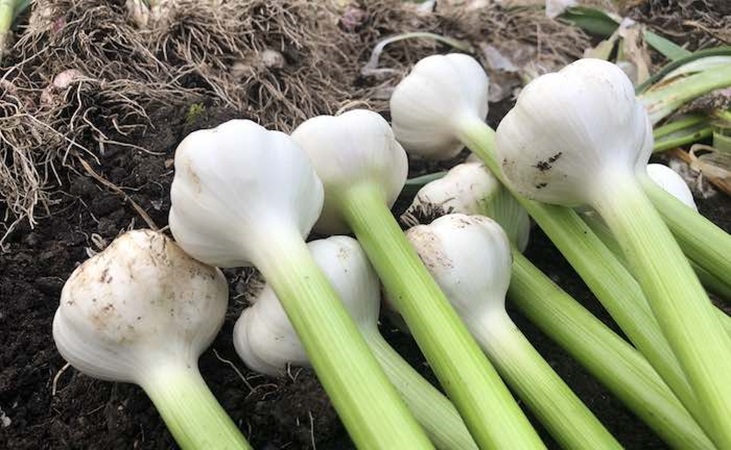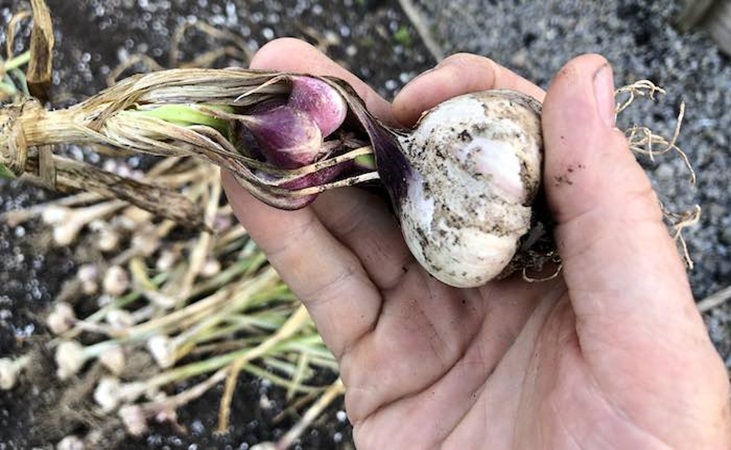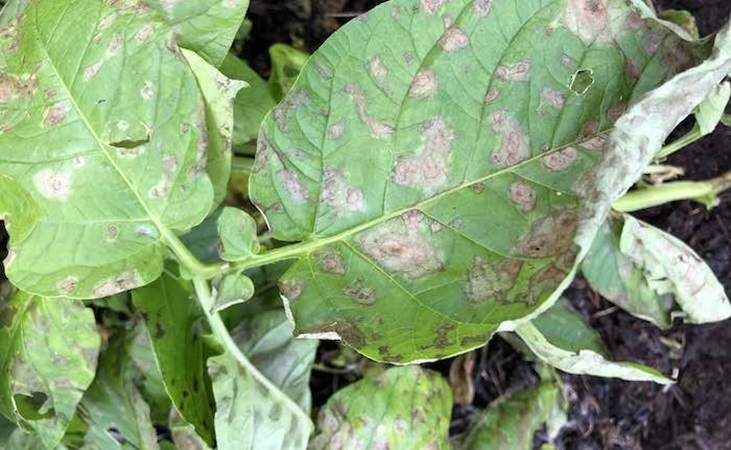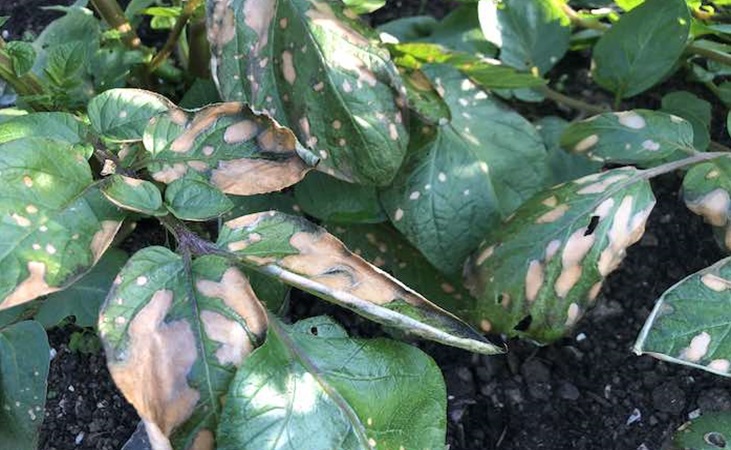Late July in the Quickcrop Vegetable Garden
Keep sowing those seeds!
I know I said it in a previous mail/blog post, but I feel I should again remind you to keep sowing seeds for late summer, autumn or overwintering crops. I know it doesn't feel like it with the good weather we are having, but every day really does count at this time of year. I don't want to upset you but the days are getting shorter, so - unlike spring when you can catch up with lengthening days - our growing window is now steadily decreasing.
If you are pushed for time and just need to get the seeds in, broadcast sow them in a tray of compost (broadcast means just fire them in without worrying about spacing). Once the seedlings come up you can prick them out and transplant them into a seedling tray, as I have done below with some lettuce plants. The other advantage of doing this, of course, is that you end up with a full seedling tray of the strongest plants from your initial sowing.

Harvesting Garlic
Last week I lifted all my outdoor garlic, which turned out to be a bit of a scrappy harvest due to the very cold start to the season. Once lifted, garlic is left to dry on the beds if the weather is suitable - and for once it is absolutely ideal.
After drying for a week or 10 days, I will tie or plait into bunches and hang in a cool dry shed (out of direct sunlight) for winter storage.

Mid-July is a little late for me for softneck garlic, but it's about right for the hardneck variety 'Lautrec Wight' (pictured above) which matures 3 weeks later.
Hardneck garlic differs because the cloves grow around a stiff central stalk rather than a soft stem. They form smaller bulbs than softnecks but have a more intense flavour, making them highly prized by cooks. They are also said to do better than softnecks in a cold spring, which was certainly the case for me this year.

By the way, if you want your garlic to look pretty for storage you are best tidying up as soon as you pick. This is my 'Lautrec' again above, which I have cleaned up by cutting off the roots and peeling off one or two leaf layers to reveal a pristine bulb (before I got them all muddy again).
You should do this as soon as you lift the garlic: the roots will be soft and so much easier to cut, and the outer skin on the bulb will come off easily. Even after a day of drying, the skin will stick to the bulb leaving you picking at it in the same manner as picking a label off a jam jar (with similar levels of success and frustration).
Garlic Top Sets
If you grew softneck garlic this year yourself, you may have noticed little garlic cloves growing in the stem - either just above the main bulb or further up the stem. I usually see one or two but had a large amount this season, the most I have ever seen.
Top sets or 'bulbils' are more commonly produced in adverse growing conditions, particularly where spring temperatures fluctuate between mild and very cold (sound familar?).

You may also see a higher instance of top sets in poorer soil, when the plant is struggling. This happened in part of my bed due, I think, to some contaminated manure - which I will get to in a minute when we look at potatoes. Anyway, we had a couple of mails asking what these funny mini garlic cloves are so there you go.
Tomato Blight
I had an email on Sunday (luckily the Quickcrop research bureau was on weekend standby mode) which contained a number of photos of ailing tomato plants, two of which I reproduce above and below. There weren't many images of affected leaves, but a number with blackened stems characteristic of tomato blight.

Remember that tomatoes are from the same family as potatoes, so they can also suffer from blight - which is common in late summer. Greenhouse or polytunnel tomatoes are less likely to to be hit as they have some shelter from wind borne spores - but also because their leaves are less likely to be wet.
Blight needs water droplets to spread. If you see the disease on plants grown undercover, remove any affected leaves or stems and only water the soil around the plant rather than the plant itself.

Saturn Greenhouse 8ft Wide
View ProductIn this case, the tomatoes are growing out in the open, so the only option is to remove diseased plant material and hope for the best. However, once the disease has taken hold it is best to remove completely to prevent spread to healthy plants.
The other possibility for a dodgy looking tomato stem is botrytis - but this is a grey rather than black discolouration, and it usually begins in a single damaged area and spreads. Multiple isolated dark brown or black patches are almost certainly tomato blight.

Potato Blight
If you read my mail from last week, you will know that the first spots of blight appeared on my first early potatoes and - even though I removed them - the disease spread to such an extent that I had to cut off all the foliage at the weekend.
Early potatoes are generally very susceptible to blight, so an attack wasn't unexpected; but they are usually out of the ground by mid-July, so blight usually isn't a big deal. This year, because of the cold start, we are a few weeks behind - so the earlies ended up in the firing line.

Potato Blight - Recognising and Avoiding
Related ArticleIf you need to remove potato foliage because of blight but still have a significant proportion of the crop in the ground, it is better to leave them buried to prevent spores on the soil surface spreading through the crop.
In the case of maincrop potatoes I would leave them in the ground for 3-4 weeks; earlies can be lifted as you need them as they are generally washed and used straight away.

Blight resistant varieties I know I will regret saying this but by way of contrast, here is the excellent blight resistant maincrop potato 'Setanta' which, so far, is showing no signs of the disease. 'Setanta' is, as far as I am concerned, one of the very best all round potato varieties with superb flavour, a fluffy texture and is rivaled only by the Hungarian 'Sarpo Mira' in blight resistance.
All blight resistant potatoes get blight in the end but they will hold out for much longer and, with the dry and sunny weather forecast here for the next while, hopefully this will be a good year.

Saving potatoes for seed I wouldn't normally recommend saving your own seed potatoes but I am just letting you know that getting stock next year may be very difficult. Brexit is the reason; last year we were able to bring all our stocks in before the iron curtain came down but 2022 is a different matter. Virtually all seed potato is produced in Scotland with any Irish produced stock going to commercial growers so things will be tricky if something isn't sorted soon.
You can save potatoes from this year's crop for planting next year but you need to be absolutely certain they don't have blight as the disease will stay alive over winter in seed potatoes and infect the crop the following year. I will go into this in more detail in a later mail but the best plan is to harvest a couple of maincrop plants when you see the very first signs of blight. The rest of the crop can tough it out for longer but at least you know the early harvested potatoes are likely to be blight free. You will need to store them at around 10˚C to prevent them from sprouting.
Hopefully some sort of exception will be made as regards import of potatoes from the UK, I will let you know as soon as I know.

Aminopyralid/Dicamba damage I have mentioned a couple of times about hormone based weedkillers being a problem in manure (and receive corresponding mails to say I was scaremongering) but again I have a first hand example of this issue. The image above is of some 'freshly' harvested new potatoes showing distorted growth caused by hormone based weedkiller in my soil that originated from contaminated horse manure.
I had noticed slow growth earlier in the season and the characteristic curled leaves but the plants recovered and went on to produce plenty of foliage. Below ground, things were different as the weedkiller mimics growth hormones and causes the weird looking tubers you see above.
The issue is caused by selective weedkillers that kill weeds but not grass and can be used on grazing animal pasture or on lawns. In the case of animals, the weedkiller is ingested and passed through the gut and out the other end, in the case of lawns, the clippings can end up in your compost. I'm not trying to cause a panic and am not saying all manure is bad, far from it, but it is definitely worth checking before spreading it. I didn't and have had numerous issues as a result.

Pea Greenshaft And finally some good news.... My peas this year are doing very nicely with heavy crops of all 3 varieties I am growing, pictured above is Hurst Greenshaft maincrop. I don't have anything terribly insightful to say about them (what's new?) other than it is important to keep picking peas to keep them productive. Unless you are growing peas for drying, picking when slightly immature yields much sweeter peas anyway so it's best to pick often to get them at their best.

Pea 'Shiraz' To finish up, here's an evening shot of my mangetout pea 'Shiraz' looking just as impressive as a sweet pea flower. 'Shiraz' also produces purple pods so another of those varieties that give a thrill to the home grower but are generally not available anywhere else.
That's it for now, I will see you next week.
Andrew
